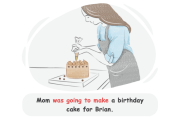Past with 'Going to'
This detailed lesson covers the Past Tense with 'Going to' in English, featuring comprehensive examples and a quiz to test your knowledge.

What Is Past with 'Going to'?
While 'be + going to' is more commonly used to talk about the future in English, it can also be used to express intentions or plans in the past. Specifically, it is used to talk about a plan or intention that did not happen or come true.
Structure
The sentence structure using 'be going to' for the past tense is:
subject + was/were + going to + base form of the verb
I was going to study for an hour, but I fell asleep.
I was going to go to the bank when suddenly I heard her crying.
Negation
To make negative sentences using 'be going to' in the past, 'not' is added after the 'be' verb (was/were) and the rest of the sentence remains unchanged. In this case, the negative marker 'not' can be contracted. For example:
They weren't going to tell anyone.
I was not going to call you.
Questions
To make yes/no questions, you need to put the past simple tense of the verb 'be' (was/were) at the beginning, followed by the subject, and then 'going to' and the rest of the sentence. Take a look at this example:
You were going to leave. → Were you going to leave?
To make wh- questions, you need wh- question words at the beginning of the question, followed by the verb 'be,' the subject, 'going to,' and the rest of the sentence. Take a look at the following example:
You were going to leave. → What were you going to do?


Be Going to: Uses
'Be going to' is commonly used in informal situations to talk about the past. It has different uses:
Predictions that didn't happen
Unfulfilled past plans or intentions
Predictions That Did Not Happen
We use be going to in the past tense to refer to events that we expected or predicted to happen at some point in the past, but did not. Here are the examples:
I thought it was going to rain, but the sun came out.
The speaker in this example means he did not study, but he had planned to.
The doctor said I was going to need surgery, but I recovered naturally.
The speakers in this example mean they did not leave, but they had intended to.
Unfulfilled Plans and Arrangements
We can use 'be going to' in the past tense to talk about what we planned or intended to do in the past, but failed to. Check out the examples.
We were going to buy a house, but prices rose too much.
She was going to travel last summer, but she got sick.
Tip!
Keep in mind that when you are talking about a plan that did not happen, you usually mention the reason.
She was going to move to Japan, but she lost her job.
Review
'Be going to' can be used to talk about events that were supposed to happen, but mostly did not.
'Be going to' is used to express past:
Predictions and expectations
Plans and arrangements
Quiz:
Which sentence is grammatically correct?
She was going to visited her friend yesterday.
They were going to leaving early.
I was going to call you, but I forgot.
We was going to buy a cake.
Sort the words to form a wh-question using 'be going to' in the past.
Correct the mistakes in these sentences.
She was going to visited the museum. → She
the museum.
We was going to buy tickets. → We
tickets.
What you were going to do? → What
?
He not was going to apologize. → He
.
Choose True or False for each statement based on the lesson.
The auxiliary "be" can be contracted when talking about past with 'going to' | |
To form negatives, place "not" after "going to." | |
"Be going to" in the past can express predictions that did not come true. | |
"Be going to" is only used in formal writing when talking about the past. |
Which sentence correctly uses "be going to" to describe an unfulfilled past plan?
They said the flight was going to be delayed, but it took off on time.
I thought it was going to snow, but it stayed sunny all day.
We thought the team was going to lose, but they won the match.
We were going to bake a cake, but we didn't have any eggs.
Comments
(0)